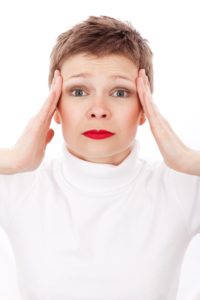Thinking About Pain – Pain Awareness Month

September Is Pain Awareness Month
People who are living with chronic pain can feel discounted and insulted when someone says “It’s all in your head.” But studies show that the way we think about pain can make a real difference in how we perceive it, and how it affects our lives.
It’s not just a matter of having a “good attitude” about pain—again, people experiencing chronic pain have every right to chafe when someone tells them that. On the other hand, most of us have experienced something like this: We feel a mysterious twinge. We pay a lot of attention to it, and wonder what’s causing it. Our experience of the pain intensifies as we worry it might be something serious. But once we receive a diagnosis, chances are our pain level will decrease even as we walk out the doctor’s office door. There is a powerful connection between pain and anxiety!
Earlier this year, Belgian researcher Anneleen Malfliet published a study in the Journal of the American Medical Association’s Neurology, showing that when patients understand what’s causing their pain, and how the pain mechanism works, they experience a lower pain level.
Malfliet, of Vrije Universiteit in Brussels, studied a group of patients who had chronic spinal pain. Half of the patients received training and education about the neuroscience of pain—what it is and how it works. These patients reported a lower perception of pain. It seems that when pain is less of a mystery, our brains pay less attention to it! When we internalize the knowledge that the pain, itself, isn’t damaging us, it is less top of mind.
There was a second, also very important, component to Malfliet’s research. People who are in pain often fear that physical activity will worsen their condition. If they have, for example, arthritis or chronic lower back problems, they might take to the couch. In turn, the resulting loss of strength and stamina almost invariably increases their pain level!
So Malfliet’s study subjects received training in proper and safe exercise techniques. This gave them confidence that even if they experienced some pain during exercise, the movements weren’t harming them—and, again, with the mystery gone, they felt less pain and anxiety. So they not only reaped the benefits of exercise, but also experienced less pain during their workout.
This is very good news for the millions of people who live with chronic pain. Today doctors are more hesitant to prescribe the traditional opioid pain medications—and studies show that those drugs are not only dangerous, but also may not actually be effective for many people. Alternatives to opioids include:
- Other medications, such as ibuprofen (Motrin), naproxen (Aleve) and acetaminophen (Tylenol)
- Physical therapy, including hands-on treatments (massage, ultrasound, hot and cold treatments), biofeedback, and training to help patients use their bodies in ways that reduce pain
- Meditation, yoga, tai chi and other mind-body practices
- Counseling to help patients understand and cope with their pain
- Managing painful health problems with regular healthcare appointments, and following the doctor’s recommendations on treatments, medications, nutrition, exercise and other lifestyle choices
Source: IlluminAge AgeWise reporting on a study published in the Journal of the American Medical Association’s Neurology.

